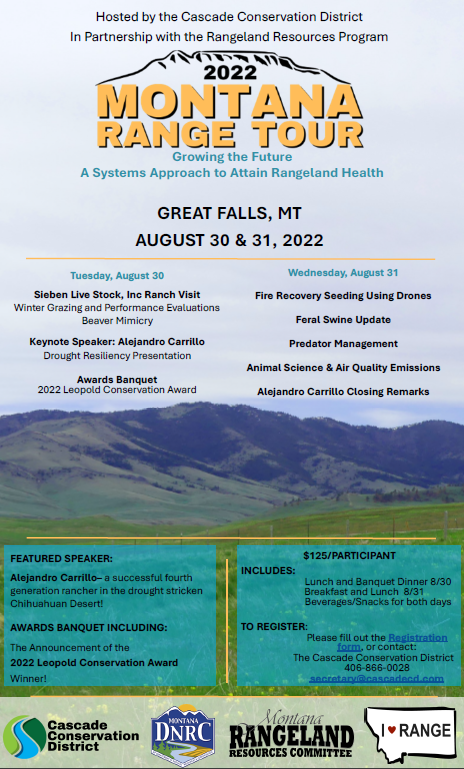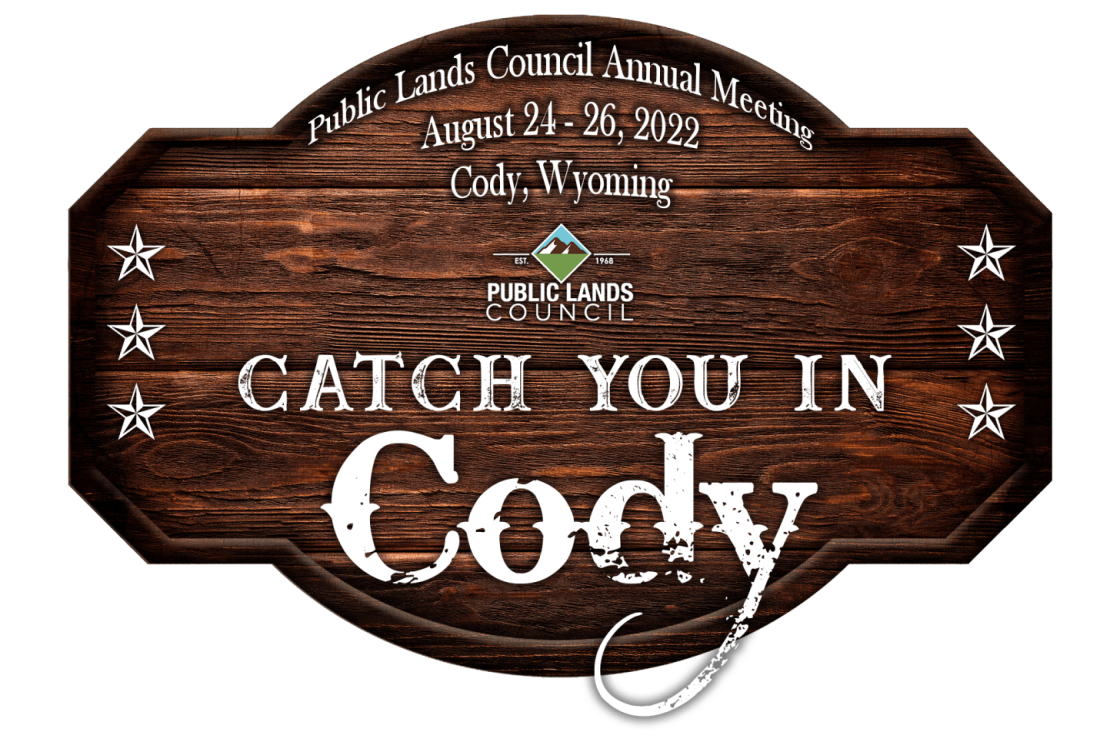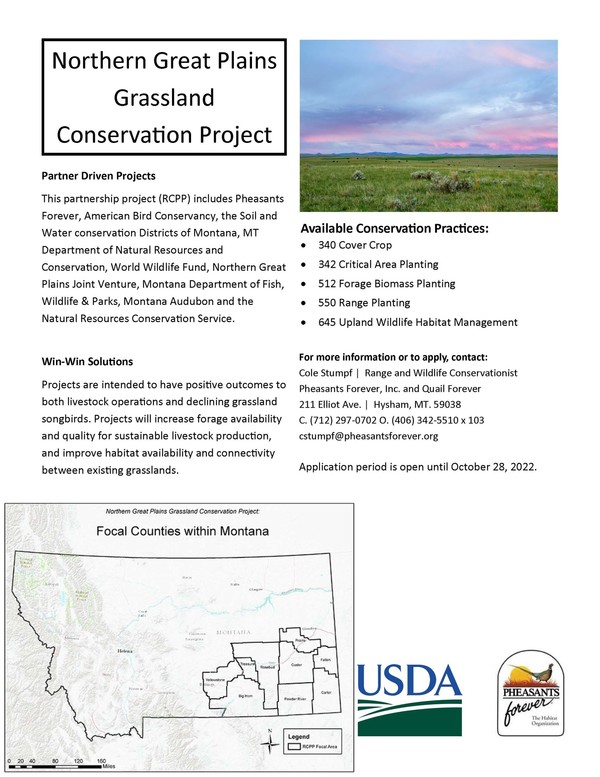Reminder: 2022 Montana Range Tour- Aug. 30 & 31!
Time is running out to register for the 2022 Montana Range Tour. Don't miss your chance to listen to international speaker Alejandro Carrillo. Alejandro
After a successful career as an IT consultant in the US and other countries in the Americas and Europe, Alejandro joined his family ranch back in 2004. Tired of the constant drought and suffering that comes with traditional ranching in the Chihuahua desert, he searched for better ways to do things.
Since 2006, he adapted the principles of Holistic Planed Grazing Management to his ranch. The change from continuous grazing to planned grazing brought many challenges as well as positive results, such as being able to increase his carrying capacity 3 times while lowering his inputs.
The field tour will be at Sieben Live Stock, this will include winter grazing practices, beaver mimicry, and lessons learned from making management changes to improve the health of the land. Sieben Live Stock Company is a family owned and managed ranch in north central Montana, where high plains meet the mountains. Raising cattle and sheep, we steward our range and practice sound business strategies to keep our lands healthy, our people thriving, and our ranch profitable.
Wait-there is more, speakers on drought, drones, feral swine and so much more.
To register please call 406-403-3767 or email secretary@cascadecd.com. Hotels are filling quickly, Crystal Inn rooms for this event will expire Aug 5th, so hurry and make your reservations today.
Crystal Inn (Host Hotel) 406-727-7788 Comfort Inn 406-564-1539
Holiday Inn Express 406-453-4000 Hilton Garden Inn 406-452-1000
Hampton Inn 406-453-2675 Heritage Inn 406-761-1900
 |

Internship Spotlight -Working Land Internship- Summer 2022 Bridger Line- in his own words
I applied for the Montana Working Lands Internship Program because I wanted to learn more about the ranching lifestyle and build off of the agricultural experience that I have to get a better understanding of what ranchers have to do to make a living out of this lifestyle.
I am studying resource conservation at the University of Montana and have
a minor in wildlife biology. This internship has furthered my education by getting real-life
hands-on work experience, learning about rangelands, learning how ranchers work with
agencies to make their ranches more efficient and wildlife friendly, and much more.
I am currently at the SC ranch in Boulder Montana which will be my last ranch.
Throughout the first four ranches, I have learned about how the drought affects
ranchers in many ways. I learned that the government has programs that help farmers
and ranchers in situations like this. However, even with the government programs, some
ranchers still have to be careful and ration their water and even may end up reducing
their herd numbers to keep afloat. So far I have had many experiences working with
machinery, irrigating hay crops, feeding and doctoring livestock, learning about
ranchlands health, attending conservation committee meetings, learning about wildlife
management, operating haying equipment, and much more.
I believe this internship has given me a great sense of what it's like to be a
landowner and will inspire me to find a career in some land management position.
Throughout the internship, I have had many conversations with people who are in
agriculture and or work for land management agencies and have gained more
knowledge about what careers there are in these fields that I may be interested in!
|
Calf Market: Northern Livestock Video Auction Recap
American Bison are Making a Major Comeback
The Fish and Wildlife Service in early June announced that several petitions to add Yellowstone bison to the List of Endangered and Threatened Wildlife under the Endangered Species Act of 1973 presented “substantial” arguments that ESA protections “may be warranted.”
Conservation efforts, responsible farming, and an ambitious relocation effort have afforded a bison population boom in recent years. While small and isolated, populations are ascending with roughly 350,000 Plains bison in production herds, 30,000 in public herds, and around 20,000 in tribal herds. To learn more about the ultimate American comeback story, Stacker explored the history of bison populations in the U.S. and repopulation efforts underway.
Read the full Article!
Bureau of Reclamation Grazes Goats for Reducing Wildfire Risk
This summer, Bureau of Reclamation will contract goat grazing activities on approximately 37- acres of the existing Auburn Shaded Fuel Break in Auburn, CA, to control the annual grasses and invasive plants (scotch broom, ornamental plants) and maintain the existing fuel break for vegetation fuel load density on Auburn Project lands along the boundary of the City of Auburn. Reclamation has previously contracted for goat grazing on three other areas in the shaded fuel break.
Read the full Project Details
 Roadmap Updates
Recently, a 2022 Central Grasslands Roadmap Summit Report has been published. The 2022 Summit was held May 23-25 in Fort Collins, CO and was designed to include grasslands stakeholders in identifying collaborative opportunities, gaps of resources, and next steps.
The Central Grasslands Roadmap would be supported by the North American Grasslands Conservation Act (NAGCA) and the congressional action of Recovering America's Wildlife Act's (RAWA).
Read the full update!
 Register for the
2022 Public Lands Council Annual Meeting!
After a long stretch of virtual meetings, PLC is excited to announce their 2022 Annual meeting in Cody, Wyoming! Join PLC August 24-26 for a full-fledged line-up of informative general sessions, policy committee meetings, cocktail hours, awards banquets, and much more. View the full agenda, here!
$325 In-Person Registration: Includes attendance to all meetings over the three-day period in Cody. From general sessions to our final banquet at the Buffalo Bill Center of the West, you will receive full access to all the week’s offerings.
$100 Virtual Registration: Receive a link to livestream each day’s general sessions and BLM Awards Luncheon on August 25th. Committee meetings and the general business meeting will not be livestreamed.
Check out the full registration options, here!
Your Drought Questions Answered...
Answers to your questions about drought - from water storage to rangeland health to marketing, these experts and ranchers discuss all things drought related. Drought presents unique challenges to ranches and livestock operations, and the best way to get through it is to learn from others and that is the goal of Good Grazing Makes Cent$ - to foster conversation and collaboration.
At the core of the mission behind Good Grazing Makes Cent$ is facilitating "conversation and collaboration between range scientists and ranchers." As a key program driver, we aim to create conversation in multiple ways to ensure that our members feel their questions are being answered.
Wondering how you can take advantage of the tailored content?
1. Tune in to live events.
2. Submit your question to our list of experts.
3. Join the Facebook discussion.
Submit a Question to GGMC Experts
Read the Full Issue
The Economic Cost of Noxious Weeds on Montana Grazing Lands
Invasions by exotic species have been cited as one of the leading causes of environmental change and decreases in biodiversity, it is estimated that nonindigenous species in the United States cause damages of $137 billion annually, with nonnative plants making up $34 billion of that cost.
On rangelands, these economic impacts are associated with livestock production; in particular, noxious weeds reduce yield and quality of forage and can poison livestock. In addition, landowners incur expenses when they implement noxious weed management strategies aimed at limiting weed invasions or managing current infestations . Overall, reductions in rangeland carrying capacity for livestock and increases in operating and management costs lead to reduced land value.
Read the scientific article!
EQC Votes to Move Forward with Draft Bill for Conservation District Funding
MACD has continued to work on a long-term funding solution for conservation districts. At the July 19th meeting of the Environmental Quality Council (EQC), the Council voted to move forward with the draft bill on conservation district funding.
This draft bill – which can be found in the legislative report title ‘Eroding Funds: HJ27 Study of Financing Conservation Districts’ would increase the total funding in the conservation districts account (managed by the MT Department of Natural Resources and Conservation) from around $3.1 million to $6 million. Conservation districts would still receive funding from coal severance taxes, with marijuana taxes making up the difference to reach a total of $6 million annually. Additionally, the bill also includes inflation adjustment in accordance with the procedures available to other local governments.
Western Sustainability Exchange Sponsors Expanding Livestock Markets Conference
Expanding Livestock Markets Conference
If you could learn from successful regenerative ranchers and progressive companies about how to increase your bottom line, would you? Join WSE to learn how you can work with nature to lower your input costs, become a more productive ranch, and receive a premium for your products! Hear from all sides--aggregate supply chain companies, verifying organizations, value-added companies, and successful regenerative ranchers taking advantage of innovative marketing opportunities.
The conference will take place September 15th and 16th from 10:00 am to 5:00pm at the Pine Meadows Golf Course, Lewistown, MT.
The conference in $75/person and the last day to register is August 31st.
Register here!

Women in Ranching Becoming Independent Organization
For the past three years, Western Landowners Alliance has been supporting and expanding women’s leadership on working rangelands through our Women in Ranching program.
We are excited to announce that Women in Ranching has fledged and is taking off on its own. WLA has supported WinR through stabilization, growth, a global pandemic, and exciting new partnerships. Now, Women in Ranching is ready to soar as an independent non-profit.
It will allow both Western Landowners Alliance, which remains fully committed to growing women's leadership in land stewardship, and Women in Ranching to deliver the strongest services and impacts to our communities. We remain a proud and prominent partner with the newly independent Women in Ranching organization!
Read the full Announcement!
|

DNRC has finalized the Flood Response Irrigation Grant Application Guidelines
Application and Guidelines are available to view but won't be open for submissions until August 1, 2022.
Governor Gianforte and the Infrastructure Advisory Commission have prioritized $1.2 million to help irrigators recover from flooding damages sustained during the Spring of 2022. Grant limits are set at $250,000 per project and applications will be considered on a "first come, first serve" basis. These grants must be for agricultural irrigation projects that are eligible for ARPA Water and Sewer Funds.
Visit the Flood Response: Irrigation Grant Program website for more information and updates.

Reminder: FWP Seeks Public Comment for Aug. 25 Commission Meeting
-
Approval of Request to Translocate Sage-Grouse to Alberta, Canada, in 2023
-
Programmatic Approval of Long-term Leases of Priority Habitat
-
Amendments to ARM 12.9.1403 Grizzly Bear Demographic Objective for the Northern Continental Divide Ecosystem
- Future Fisheries Improvement Projects, Summer 2022 funding cycle
- Big Snowy Mountains WMA Fee Title Acquisition, Region 5
- Pheasant releases for recruiting and retaining hunters
The commission will make a final decision on these proposals at its Aug. 25 meeting.
To comment and for more information on the full list of proposals, go online to the FWP Commission Webpage.
FWP Seeks Public Input on Revisions to Elk Management Plan
FWP is seeking input on the existing elk population objectives and local elk management challenges that should be considered in the revision. The scoping period started several weeks ago, but meetings have been sparsely attended and FWP has received few comments to date.
FWP will be hosting a series of public meetings this summer and fall to gather ideas about local elk management issues and population objectives. See meeting schedule, or see the 'Save the Date' section, below.
Information on current elk population objectives being considered for revision can be viewed here. FWP would like feedback on relative population objectives as well as individual hunting districts.
The deadline for public comment is October 15, 2022.

DEQ Seeking Public Comment on State Revolving Fund Intended Use Plans & Priority Projects- Water Quality
DEQ invites comments on the Intended Use Plans and Proposed proposed Project Priority Lists for State Fiscal Year 2023 for both the Drinking Water and the Water Pollution Control State Revolving Fund (SRF) Loan Programs. The Intended Use Plans identify the intended uses of funds in the loan programs and describes how the goals of the programs will be satisfied.
The Project Priority Lists identify projects that are eligible to be funded with loan monies authorized and appropriated to the State of Montana through Federal Fiscal Year 2022 funding.
Associated Materials:
Comment Period Ends: August 10, 2022
Send Comments To:
By email to Mark Smith (marks@mt.gov), Drinking Water Revolving Fund Program Manager, or Mike Abrahamson (MAbrahamson@mt.gov), Water Pollution Control Revolving Fund Program Manager,
Or by mail to DEQ/SRF, PO Box 200901, Helena, Montana 59620-0901

Soil Health is Key to a Healthy Planet
Healthy soil gives us clean air and water, bountiful crops and forests, productive grazing lands, diverse wildlife, and beautiful landscapes. Thanks to the soil professionals, farmers and growers conserving our soil and improving our global soil health.
Learn more about the ABCs of Soil Health.

USDA Accepts More than 3.1 Million Acres in Grassland CRP Signup
The U.S. Department of Agriculture (USDA) is accepting offers for more than 3.1 million acres from agricultural producers and private landowners through this year’s Conservation Reserve Program (CRP) Grassland Signup, the highest in history.
Grasslands enrolled in CRP help sequester carbon in vegetation and soil, while enhancing resilience to drought and wildfire. Meanwhile, producers can still conduct common grazing practices, such as haying, mowing, or harvesting seed from the enrolled land, which supports ag production.
Because Grassland CRP supports not only grazing operations but also biodiversity and conserving environmentally sensitive land such as that prone to wind erosion, USDA’s Farm Service Agency (FSA) created two National Priority Zones in 2021: the Greater Yellowstone Migration Corridor and Dust Bowl Zone. For this year’s signup, FSA expanded the Greater Yellowstone Wildlife Migration Corridor Priority Zone to include seven additional counties across Montana, Wyoming, and Utah, to help protect the big-game animal migration corridor associated with Wyoming elk, mule deer and antelope.
Producers can still make an offer to participate in CRP through the Continuous CRP Signup, which is ongoing, by contacting the FSA at their local USDA Service Center.
Read the full Press Release, here!

Scientists Explore Gene Editing to Manage Invasive Species
In the U.S., the environmental and economic costs caused by invasive species are estimated to exceed $120 billion per year. Since invasive pests have few or no natural predators, they can quickly spread, and throw off entire ecosystems by pushing out native species and reducing biological diversity.
To protect our vital resources from invasive species, APHIS scientists are exploring the feasibility of genetically modifying traits in invasive species to manage their populations, control diseases, create new detection tools for plant pathogens and more. These technologies are faster, cheaper, and more accurate than previous molecular tools—allowing scientists to target specific species and genes.
What is on the horizon? Our researchers are studying gene-drive technology to promote single-sex offspring in invasive rodents. If successful, a modified rodent population that only produces male or female offspring would eventually breed itself into its last generation -- without the use of chemical pesticides in an island ecosystem.
Will gene editing be the future of invasive pest management? Visit Solutions Through Science: Exploring Emerging Genetic Technologies to learn more.

BLM Seeks Public Comment on the Seymour Creek Parcel Acquisition
The public is invited to comment on a proposal by the Bureau of Land Management (BLM) to acquire the 3,600-acre Seymour Creek parcel in the Big Hole River Watershed.
The proposed acquisition is about 55 miles south of Butte, in Beaverhead (est. 3,178 acres) and Deerlodge (est. 422 acres) Counites. The Seymour Creek parcel is approximately 13 miles upstream from the confluence of the Big Hole River and Wise River.
The existing private landowners are partnering with the Rocky Mountain Elk Foundation (RMEF) and BLM to conserve their family lands in southwest Montana through this Land and Water Conservation Fund acquisition. The comment period for the public to share any issues and concerns that should be considered by the BLM during their environmental assessment planning process to evaluate the impacts of acquiring the acreage will close on August 4, 2022.
Read the full Press Release

Expansion of National Wildlife Refuge System with Lost Trail Conservation Area in Montana
Secretary of the Interior Deb Haaland today announced the establishment of the Lost Trail Conservation Area in Northwest Montana as the 568th and newest unit of the National Wildlife Refuge System, managed by the U.S. Fish and Wildlife Service.
The Service worked in partnership with the Trust for Public Land and the Confederated Salish and Kootenai Tribes (CSKT) to purchase the 38,052-acre conservation easement from continuing owner Southern Pine Plantations Montana. Overlaying existing private lands, the Conservation Area will protect crucial wildlife habitats and migration corridors for elk, mule deer, grizzly bear, wolverine, and Canada lynx, between Glacier National Park, the Cabinet Mountains Wilderness, the Selkirk Mountains and into the Coeur d’Alene Mountains in Idaho.
Read the full Press Release!

Our Wyoming Life- First Day of Haying 2022
This month's Podcast Corner will not feature a podcast-but instead a video! Ride along with the Our Wyoming Life ranch family as they embark on their first haying season since three full years of drought
Watch here!
|
MSU Extension:
Updated MontGuides
University of Montana:
Rangeland Analysis Platform
Reversing Tree Encroachment Increases Usable Space for Sage-Grouse during the Breeding Season
USDA-Agricultural Research Service
Scientific Discoveries 2022
Rangeland Resources & Systems Research, Fort Collins, CO:
Livestock and Range Research Laboratory, Miles City, MT:
Pest Management Research, Sidney, MT:
USDA- Wildlife Services:
US Forest Service Research & Development:
Research topic: Fire
Research topic: Water, Air, & Soil
August 2022:
- Aug. 2nd 6pm, FWP Elk Plan Public Scoping- Lewistown
- Aug. 3rd, Governor's Drought and Water Supply Advisory Committee and Drought Task Force Meeting, Helena
- Aug. 3rd 6pm, FWP Elk Plan Public Scoping- Gardiner
- Aug. 4th 6pm, FWP Elk Plan Public Scoping- Lewistown
- Aug. 5th, CLEAR30 Sign Up Deadline
- Aug. 8th 6pm, FWP Elk Plan Public Scoping- Livingston
- Aug. 9th 6pm, FWP Elk Plan Public Scoping- Malta
- Aug. 10th 6:30pm, FWP Elk Plan Public Scoping- Boulder
- Aug. 11th 6pm, FWP Elk Plan Public Scoping- Glasgow
- Aug. 11th 6pm, FWP Elk Plan Public Scoping- Winnett
- Aug. 15th 7pm, FWP Elk Plan Public Scoping- Great Falls
- Aug. 16th 6pm, FWP Elk Plan Public Scoping- Bozeman
- Aug. 16th 6pm, FWP Elk Plan Public Scoping- Havre
- Aug. 16th 7pm, FWP Elk Plan Public Scoping- White Sulphur Springs
- Aug. 17th 7pm, FWP Elk Plan Public Scoping- Chester
- Aug. 18th 7pm, FWP Elk Plan Public Scoping- Stanford
- Aug. 22nd 6pm, FWP Elk Plan Public Scoping- Libby
- Aug. 23rd 7pm, FWP Elk Plan Public Scoping- Augusta
- Aug. 23rd 6pm, FWP Elk Plan Public Scoping- Kalispell
- Aug. 24th 6pm, FWP Elk Plan Public Scoping- Eureka
- Aug. 24-25th, 2022 Public Lands Council Annual Meeting- Cody, WY
- Aug. 25th 7pm, FWP Elk Plan Public Scoping- Craig
- Aug. 25th 6pm, FWP Elk Plan Public Scoping- Thompson Falls
- Aug. 25th, Montana FWP Commission Meeting
- Aug. 30-31st, 2022 Range Tour- Cascade County
- Aug. 31st 7pm, FWP Elk Plan Public Scoping- Fort Benton
September 2022:
Stacey Barta, State Coordinator for Rangelands
(406) 594-8481
SBarta@mt.gov
Rangeland Resources Committee:
Diane Ahlgren, Chair
John Hollenback, Vice Chair
Sigurd Jensen
Jim Anderson
Leah Lewis
Ron Devlin
|